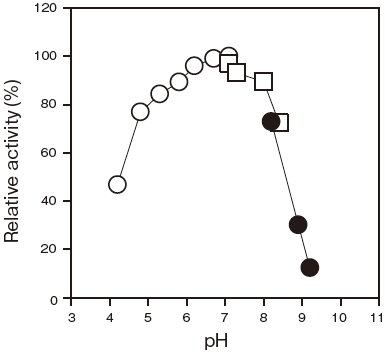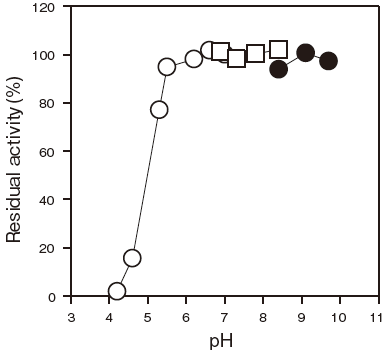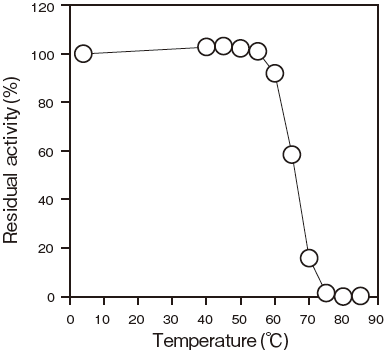Preparation and Specification
- Appearance
- : Pale grayish to grayish or brownish to light purple lyophilizate
- Specific activity
- : More than 30 U/mg solid
- Contaminants
- :
- Catalase
- Less than 0.6 % (U/U)
- Glucose oxidase
- Less than 0.02 % (U/U)
Properties
- Substrate specificity
- : See Table 1
- Molecular weight
- : 58 kDa (SDS-PAGE)
- Isoelectric point
- : pH 5.9 (estimated from amino acid sequence)
- Michaelis constants
- : 1,2-Dioleoyl-sn-glycero-3-phosphocholine 9.3 × 10−4 M
- Optimum pH
- : 6.7–7.1Figure 1
- pH stability
- : 5.3–9.7Figure 2
- Thermal stability
- : Stable at 60℃ and below (pH 8.0, 10 min) Figure3
- Storage stability
- : At least one year at −20℃
- Effect of metal ions
- : See Table 2
- Activator
- : Ca2+
Applications for Diagnostic Test
This enzyme is useful for enzymatic determination of phospholipids when coupled with choline oxidase (T–05) .
| PLDⅡ | ||
| Phosphatidylcholine + H2O | → | Choline + Phosphatidic acid |
| COD | ||
| Choline + 2 O2 + H2O | → | Betaine + 2 H2O2 |
| POD | ||
| 2 H2O2 + 4-AA + Phenol | → | Quinoneimine dye + 4 H2O |
Table 1. Substrate specificity
| Substrate | Specific activity (%) |
|---|---|
| 1,2-Dioleoyl-sn-glycero-3-phosphocholine |
100 |
| 2-Oleoyl-1-palmitoyl-sn-glycero-3-phosphocholine |
98 |
| L-α-Phosphatidylcholine |
95 |
| L-α-Lysophosphatidylcholine |
99 |
| 1-Oleoyl-sn-glycero-3-phosphocholine | 99 |
| L-α-phosphatidylethanolamine |
14 |
| Sphingomyelin | 26 |
Table 2. Effect of metal ions (Activators)
| Divalent cation (1 mM) |
Relative activity (%) |
|---|---|
| None |
2 |
| Ca2+ | 100 |
| Mg2+ | 2 |
| Mn2+ | 0 |
| Ba2+ | 1 |
Assay
Principle
- The assay is based on the increase in absorbance at 500 nm as the formation of quinoneimine dye proceeds in the following reactions:
| PLD Ⅱ | ||
| Lecithin +H2O | → | Phosphatidic acid+Choline |
| COD | ||
| Choline +2 O2+H2O | → | Betaine+2H2O2 |
| POD | ||
| 2 H2O2+4–AA+Phenol | → | Quinoneimine dye+4 H2O |
COD: Choline oxidase
Unit definition
-
One unit is defined as the amount of enzyme which hydrolyzes 1 μmole of phosphatidylcholine to phosphatidic acid and choline per minute at 37℃ under the conditions specified in the assay procedure.
Reagents
- Reaction mixture for the first reaction
0.1 M Tris–HCl buffer pH 8.0 0.20 ml 0.1 M CaCl2 solution 0.05 ml 25 mM substrate solution 1) 0.10 ml
-
Distilled water 0.15 ml 1) : 25 mM substrate solution
Dissolve 88.5 mg of 1,2-Dioleoyl-sn-glycero-3-phosphocholine with 4.5 ml of 5 % (W/V) Triton X–100 solution. - Reaction mixture for the second reaction
EDTA: Ethylenediaminetetraacetic acid15 mM 4–AA solution 0.10 ml 0.2 % (W/V) Phenol solution 0.10 ml 60 mM EDTA pH 8.0 0.10 ml 50 mM Tris–HCl buffer pH 8.0 2.00 ml 90 U/ml POD solution 2) 0.10 ml 30 U/ml COD solution 3) 0.10 ml 2) : 90 U/ml POD solution
Dissolve 900 U (PPU) of POD with 10 ml of distilled water.3) : 30 U/ml COD solution
Dissolve 300 U of COD with 10 ml of 10 mM Tris–HCl buffer pH 8.0. - Enzyme dilution buffer
10 mM Tris–HCl buffer (pH 8.0) containing 0.05%
(W/V) BSA and 0.1% (W/V) Triton X–100 - Reagents
Triton X–100: The Dow Chemical Company
1,2-Dioleoyl-sn-glycero-3-phosphocholine:Sigma Chemical Co. #P–6354EDTA (2 Na・2H2O) : KISHIDA CHEMICAL Co., Ltd.#060–29133
- COD: Asahi Kasei Pharma Corporation #T–05
BSA: Millipore Fraction V pH 5.2 #81–053
4–AA : NACALAI TESQUE, INC. Special grade #01907–52
POD: Sigma Chemical Co. Type Ⅱ #P–8250
Enzyme solution
-
Accurately weigh about 20 mg of the sample and add enzyme dilution buffer to make a total of 20 ml. Dilute it with enzyme dilution buffer to adjust the concentration as required.
Procedure
- Pipette accurately 0.50 ml of reaction mixture for the first reaction into a small test tube and preincubate at 37℃.
- After 5 min, add 50 μl of enzyme solution and mix to start the reaction at 37℃.
- At 10 min after starting the reaction, add 2.50 ml of reaction mixture to the second reaction and mix to start the second reaction.
※ In the case of a blank test, add 50 μl of enzyme dilution buffer solution at this time. - At 20 min after starting the reaction, measure the absorbance at 500 nm.
-
△ A = (As-Ab) ≦ 0.60 AbsAbsorbance sample : As blank : Ab
Calculation
- Activity (U/mg of powder) = {(△A/10)/(12.2)} × 3.05/0.05 × 1/x
-
12.2 : millimolar extinction coefficient of quinoneimine dye (cm2/ μmole) 10 : reaction time (min) 3.05 : final volume (ml) 0.05 : volume of enzyme solution (ml) X : concentration of the sample in enzyme solution ( mg/ml)
Storage
-
Storage at -20℃ in the presence of a desiccant is recommended. Enzyme activity will be retained for at least one year under this condition.
References
- Imamura, S. and Horiuchi, Y. (1979) J. Biochem., 85, 75–95.
PLDⅡ 活性測定法 (Japanese)
試薬液
- 第一反応試薬混合液
0.1M トリス-HCl 緩衝液pH8.0 0.20 ml 0.1M 塩化カルシウム溶液 0.05 ml 25mM 基質溶液1) 0.10 ml 精製水 0.15 ml 1) : 25mM 基質溶液
1 , 2 -ジオレオイルsn- グリセロ- 3 - ホスホコリン88.5mg を5% (W/V) トリトンX–100 溶液4.5ml で溶解する。 - 第二反応試薬混合液
15mM 4–AA 溶液 0.10 ml 0.2% (W/V) フェノール液 0.10 ml 60mM EDTA 溶液pH8.0 0.10 ml 50mM トリス-HCl 緩衝液pH8.0 2.00 ml 90U/ml POD 溶液2) 0.10 ml 30U/ml COD 溶液3) 0.10 ml 2) : 90U/ml POD 溶液
POD 900 単位 (PPU) を精製水10ml で溶解する。3) : 30U/ml COD 溶液
COD 300 単位 (U) を10mM トリス-HCl 緩衝液pH8.0 10ml で溶解する。 - 酵素溶解希釈用液
0.05% (W/V) BSA と0.1% (W/V) トリトンX–100 を含む10mM トリス–HCl 緩衝液pH8.0 - 試薬
トリトンX–100:Dow Chemical 製
1 , 2 -ジオレオイルs n -グリセロ- 3 -ホスホコリン:シグマ製 #P–6354
-
EDTA (エチレンジアミン四酢酸・2Na・2H2O) :
キシダ化学製 #060–29133COD (コリン酸化酵素) :旭化成ファーマ製 #T–05
BSA: Millipore 製 Fraction V pH5.2 #81–053
4–AA:ナカライテスク製 特級 #01907–52
POD:シグマ製 Type Ⅱ #P–8250
酵素試料液
- 検品約20mg を精密に量り、酵素溶解希釈用液で全容20ml とする。
その液を酵素溶解希釈用液で適宜希釈する。
測定操作法
- 小試験管に第一反応試薬混合液0.50ml を正確に分注し、37℃で予備加温する。
- 5 分経過後、酵素試料液50 μl を正確に加えて混和し、37℃で第一反応を開始する。
- 10 分経過後、第二反応試薬混合液2.50ml を加えて混和し、37℃で第二反応を開始する。
※ 盲検はこの時点で酵素溶解希釈用液50 μl を加える。 - 20 分経過後、500nm における吸光度を測定する。求められた吸光度を試料液はAs、盲検液はAb とする。
ΔA = (As-Ab) ≦ 0.60Abs
計算
活性 (U/mg) = {(ΔA/10)/(12.2)} × 3.05/0.05 × 1/x| 12.2 : | キノンイミン色素の500nm におけるミリモル分子吸光係数 (cm2 / μmole) |
| 10 : | 反応時間 (min) |
| 3.05 : | 反応総液量 (ml) |
| 0.05 : | 反応に供した酵素試料液量 (ml) |
| X : | 酵素試料液中の検品濃度 (mg/ml) |






